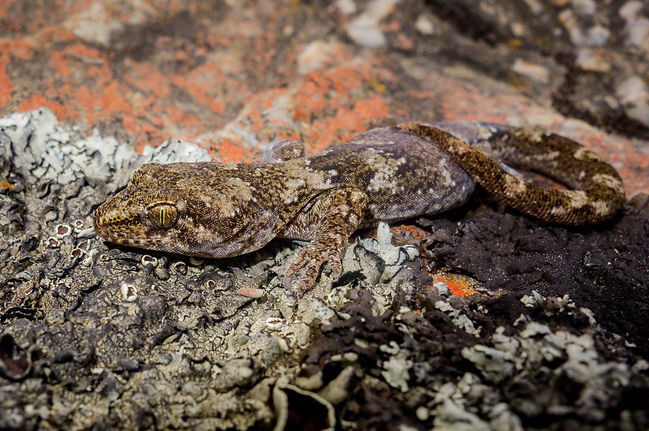Home > Our lizards > Schist gecko
Schist Gecko
English name: Schist gecko
Scientific name: Woodworthia “Central Otago”
Conservation status: At risk, declining.
Found: Central Otago: Areas of the Clutha Valley between Clyde and Beaumont; northern Old Man Range; southern Raggedy Range; Rough Ridge.
Size: Up to 71mm SVL
Did you know: Its tongue is pink with a grey tip.

Schist gecko. Carey Knox
%20copy.jpg)
Schist gecko. Carey Knox
As its name suggests, the schist gecko lives on schist rock outcrops, where its colouration makes it exquisitely camouflaged. It is now confined to a small part of the driest area of Central Otago.
The schist gecko is nocturnal, and will forage for insects during the night. It also eats some fruit. During the day it occupies deep crevices and hides under loose slabs. When it comes out to sun-bask on the rock, it often stays in partial concealment at a retreat entrance.In areas where there are sufficient numbers of schist gecko left, they can congregate in large groups. They give birth to live twins in February after a nearly year-long gestation.
A small to medium sized gecko, the schist gecko has brown or olive-brown skin with irregular paler blotches and bands, and speckles of black and beige. Its skin simulates the colouration of the local lichen-covered schist outcrops. Its mouth lining and tongue are pink, with a grey tip on the tongue. The soles of its feet are a pale brown.
SVL: Snout to vent length. A measurement of size taken from the tip of an animal's nose to the opening of the cloaca (the combined excretory and genital opening) at the base of the tail. It is the common length measurement used for lizards.
Hitchmough, R. et al. (2015). Conservation Status of New Zealand Reptiles 2015. New Zealand Threat Classification Series 17. Department of Conservation. Wellington, NZ.
https://www.doc.govt.nz/Documents/science-and-technical/nztcs17entire.pdf
van Winkel et al. (2018). Reptiles and amphibians of New Zealand: A field guide. New Zealand: Auckland University Press.
